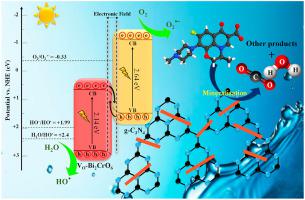Chemosphere ( IF 8.8 ) Pub Date : 2021-09-21 , DOI: 10.1016/j.chemosphere.2021.132273 Farzad Hasanvandian 1 , Mohsen Moradi 1 , Sina Aghaebrahimi Samani 2 , Babak Kakavandi 3 , Shahrbanoo Rahman Setayesh 4 , Mohammad Noorisepehr 3

|
In this research, the potential of bismuth chromate (BCO), a new bismuth-based semiconductor belongs to the family of Bi2XO6 (X = Mo, W, or Cr), was introduced by a novel 1D/2D structure consist of BCO nanobelts and N2-freezed ultra-wrinkled graphitic carbon nitride (N–CN) nanosheets. To enhance intimate contact between BCO and N–CN (BCO/N–CN composite), surface oxygen vacancy (VO) was created as an efficient electron transfer highway using a simple alkaline-treatment-assisted method. Various characterization techniques, including XRD, FT-IR, EPR, FE-SEM, TEM, BET, DRS, PL, EIS, and photocurrent transient analyses were conducted to elucidate the physicochemical aspects of catalysts. The synthesized catalysts were subjected to levofloxacin (LVFX) photodegradation and optimum conditions were found under LED irradiation. Under optimum conditions, about 92.5% of LVFX was catalytically degraded over VO-rich BCO/N–CN heterojunction after 120 min of reaction, which was 2.3 folds higher than that of VO-free composite. The obtained heterojunction maintained superior performance after five consecutive runs with no noticeable changes in the XRD and FT-IR patterns, demonstrating the high stability of synthesized nanocomposite. Thus, the proposed interfacial engineering in this study opens new insight for ameliorating the insufficient interfacial contact between components of heterojunctions. This study not only presents a new bismuth-based photocatalyst for antibiotic degradation but also sheds light on the charge migration behavior in favor of efficient Z-type heterojunction.
中文翻译:

通过表面氧空位和与铋基半导体偶联有效促进g-C3N4光催化性能降解抗生素
在这项研究中,铬酸铋 (BCO) 是一种新的铋基半导体,属于 Bi 2 XO 6(X = Mo、W 或 Cr)家族,它的潜力是通过一种新颖的 1D/2D 结构引入的BCO 纳米带和 N 2冷冻超皱石墨氮化碳 (N-CN) 纳米片。为了增强 BCO 和 N-CN(BCO/N-CN 复合材料)之间的密切接触,表面氧空位(V O) 是使用简单的碱处理辅助方法创建的高效电子传输高速公路。进行了各种表征技术,包括 XRD、FT-IR、EPR、FE-SEM、TEM、BET、DRS、PL、EIS 和光电流瞬态分析,以阐明催化剂的物理化学方面。合成的催化剂经过左氧氟沙星 (LVFX) 光降解,并在 LED 照射下找到了最佳条件。在最佳条件下,约92.5 LVFX的%进行催化降解ν个ö富BCO / N-CN后异质结120分钟的反应,这比的V 2.3倍更高ö- 无复合。获得的异质结在连续五次运行后仍保持优异的性能,XRD 和 FT-IR 图案没有明显变化,表明合成的纳米复合材料具有高稳定性。因此,本研究中提出的界面工程为改善异质结组件之间的界面接触不足开辟了新的视角。这项研究不仅提出了一种用于抗生素降解的新型铋基光催化剂,而且还揭示了电荷迁移行为,有利于有效的 Z 型异质结。


























 京公网安备 11010802027423号
京公网安备 11010802027423号